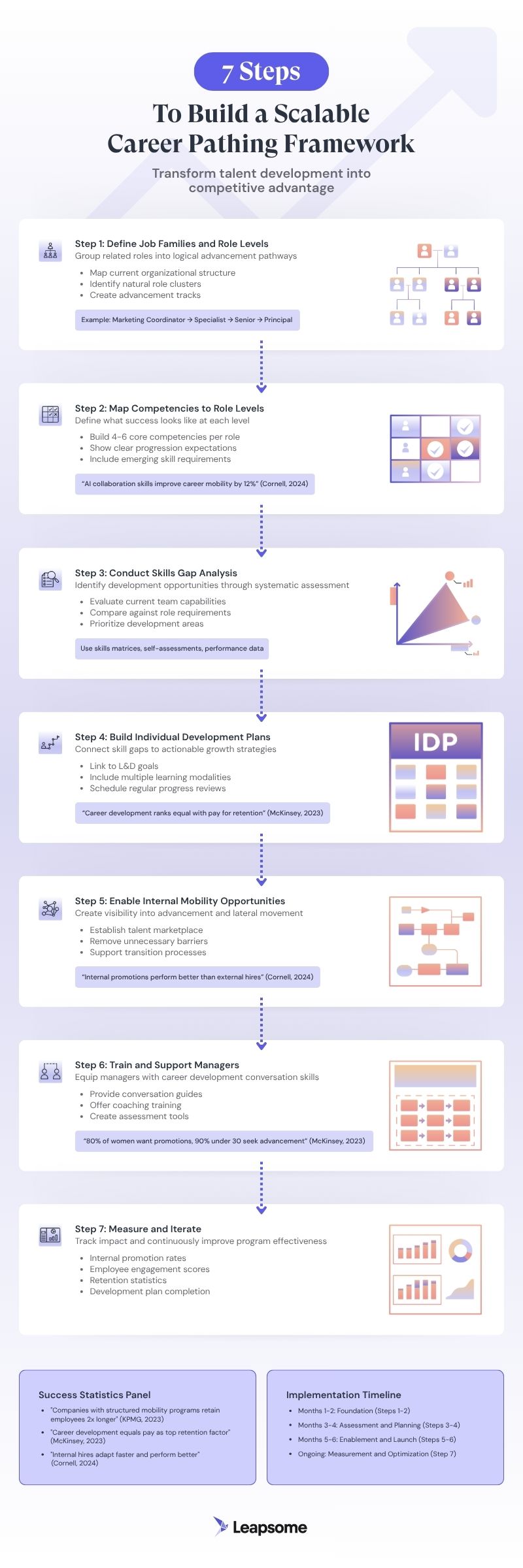Career pathing: a practical guide for people-first companies

This guide will show you how to build and roll out a scalable career pathing program in 7 steps — with organizational examples, implementation tips, and templates.
Career pathing drives internal mobility, boosts employee retention, and empowers managers to support meaningful growth conversations. Companies with structured internal mobility programs retain employees twice as long (1) as those without them, while career development now ranks equal with compensation as the primary factor influencing job acceptance decisions.
The most effective programs extend beyond traditional career ladders to include lateral movement opportunities, competency-based progression, and technology-enabled talent mobility. Organizations that master these elements create competitive advantages through enhanced employee engagement, reduced turnover costs, and stronger succession planning capabilities.
The framework outlined here transforms theoretical career development concepts into actionable implementation strategies that work for growing organizations across industries.
🚀 Transform career development into a strategic advantage
Build scalable career paths that drive retention and business growth.
👉 Book a demo
(1) KPMG, 2023
Before you start: 4 ingredients of a strong career pathing program
Building an effective career pathing program requires strategic thinking about your foundation. The most successful initiatives share four core elements that create the conditions for sustainable growth and meaningful employee development.
1. A clear competency framework
A well-designed competency framework serves as your program's backbone, defining success at each level while creating shared expectations across the organization. Cornell ILR research demonstrates that formal internal posting processes consistently outperform informal networks by improving transparency and match quality.
The workplace is evolving rapidly, and traditional frameworks often struggle to capture emerging skill requirements. Recent research reveals that AI usage patterns now improve prediction of career mobility by 12% beyond traditional skill measures. This means competency frameworks benefit from including how employees interact with technology, adapt to change, and collaborate across functions rather than focusing solely on static job descriptions.
Organizations that invest in comprehensive competency frameworks often find that AI-powered tools can help identify these evolving patterns, creating role definitions that balance current requirements with future skill demands.
2. Buy-in from leadership and managers
Strong leadership support transforms career pathing from an HR initiative into a business strategy. The data makes a compelling case: companies with structured internal mobility programs retain employees twice as long as those without them. When leaders understand this return on investment, they typically provide the resources and manager training necessary for program success.
Middle managers deserve particular attention in this process. They're increasingly recognized for their connection and integration capabilities, and frameworks that acknowledge both vertical advancement and lateral growth opportunities tend to generate stronger engagement across all levels.
3. Visibility into role levels and expectations
Transparency eliminates the guesswork that often frustrates employees and managers alike. KPMG research highlights that 25% of employees lack diverse work experiences while 20% lack visibility into internal career options. Organizations that address these gaps through clear competency expectations and advancement criteria often see significant improvements in employee satisfaction and internal mobility rates.
4. A scalable tool (like Leapsome)
Manual processes work well for small teams but become unwieldy as organizations grow. Technology platforms that integrate performance management, learning and development, and succession planning can transform how you deliver career pathing at scale. Talent marketplaces represent a significant advancement in this area, democratizing mobility by matching employees to roles and projects in real time while breaking down traditional organizational silos.
7 steps to build a scalable career pathing framework
Creating a career pathing framework that works across your organization requires systematic planning and thoughtful execution. The following seven-step approach provides a practical roadmap that you can adapt to your company's unique needs and culture, whether you're starting from scratch or refining an existing program.
1. Define job families and role levels
Job families group roles that share similar skills, functions, or career paths. Think of them as career highways with multiple lanes for advancement.
Start by organizing related roles into logical families. A marketing family might progress from coordinator to CMO, with separate tracks for individual contributors and managers.
Things you'll want to consider:
- Create meaningful progression at each level
- Include both vertical and lateral advancement options
- Account for emerging skills like AI collaboration
Research shows that middle managers are increasingly valued for connection roles, so avoid forcing all high performers into management tracks.
Here's how it might look: Marketing Family
- IC Track: Coordinator → Specialist → Senior Specialist → Principal
- Management Track: Coordinator → Manager → Senior Manager → Director → CMO
2. Map competencies to each role level

Competencies define what success looks like at each level, creating a shared language for development conversations. Think beyond generic job descriptions to focus on specific skills, behaviors, and knowledge that drive performance.
Your competency mapping should show clear progression between levels. A junior marketing specialist needs basic campaign execution skills, while a senior specialist requires strategic thinking and cross-functional collaboration abilities.
Competency progression example:
- Level: Junior
- Strategic thinking: Understands team goals and priorities
- Collaboration: Works effectively within immediate team
- Technical skills: Executes standard processes with guidance
- Level: Mid-level
- Strategic thinking: Connects work to department objectives
- Collaboration: Collaborates across functions on projects
- Technical skills: Adapts processes and troubleshoots independently
- Level: Senior
- Strategic thinking: Develops strategies that align with business goals
- Collaboration: Influences cross-functional decisions
- Technical skills: Designs new processes and mentors others
- Level: Principal/Lead
- Strategic thinking: Shapes organizational strategy and direction
- Collaboration: Leads complex, multi-stakeholder initiatives
- Technical skills: Drives innovation and sets technical standards
Studies show that cognitive skills combined with iterative AI collaboration create the strongest advancement opportunities, making it valuable to include technological fluency alongside traditional competencies.
What works best in practice:
- Include 4-6 core competencies per role
- Show progression from basic to advanced mastery
- Balance technical skills with behavioral competencies
- Update regularly based on business needs
Tools like Leapsome's competency framework can streamline this process, positioning the framework as a practical career pathing template that evolves with your organization.
3. Conduct a skills gap analysis
Skills gap analysis reveals the difference between current capabilities and future needs, providing the foundation for targeted development planning. This assessment guides both individual growth plans and organizational learning investments.
Start by evaluating current skill levels across your teams using employee self-assessments, manager evaluations, and performance data. Compare these findings against the competency requirements you've mapped for each role level.
Technology is reshaping workforce capabilities faster than organizations can adapt. Research shows that employees who use AI as a collaborative tool for iteration and enhancement tend to advance more quickly than those who rely on AI primarily for task automation. This suggests that successful organizations don't just track technical skills — they assess how people approach problem-solving and technology adoption.
Strategic approaches for comprehensive analysis:
- Use skills matrices to visualize gaps across teams and functions
- Include employee self-assessments for honest capability insights
- Focus on both current role requirements and next-level expectations
- Identify organization-wide patterns alongside individual development needs
The analysis should reveal actionable insights about where to focus development efforts. You might discover that your marketing team excels at creative strategy but needs stronger data analysis capabilities, or that your engineering group has deep technical expertise but requires enhanced cross-functional collaboration skills.
Understanding these patterns creates opportunities to design targeted employee development methods that address both immediate needs and future organizational goals.
4. Build individual development plans
Individual development plans transform skills gap insights into actionable growth strategies. These plans work most effectively when they align personal aspirations with organizational capabilities, creating clear advancement pathways while addressing critical skill deficiencies.
Successful development planning requires strategic integration across multiple learning modalities. Organizations benefit from combining formal training programs, stretch assignments, mentoring relationships, and cross-functional project opportunities. Research indicates that career development now ranks equal with pay as the primary factor influencing job acceptance and retention decisions.
The most impactful plans establish direct connections between performance management systems and learning platforms. When you create comprehensive employee development plans that integrate with broader L&D objectives through platforms like Leapsome Learning, employees gain visibility into their progress while managers develop enhanced understanding of team development trajectories.
Strategic approaches for development plan effectiveness:
- Connect specific goals to competency gaps identified through systematic analysis
- Balance short-term skill acquisition with long-term career advancement objectives
- Incorporate diverse employee development methods for comprehensive growth
- Establish regular progress reviews to adapt plans based on evolving organizational needs
Well-designed individual development plans also create strategic opportunities for internal mobility by systematically preparing employees for roles across different functions and organizational levels, ultimately strengthening your talent pipeline.
5. Enable internal mobility opportunities
Internal mobility transforms career pathing from theoretical frameworks into real advancement opportunities. When organizations create systematic visibility into open roles, lateral moves, and project-based learning experiences, they often discover that employees become more engaged while retention rates improve significantly.
The most effective mobility programs focus on removing barriers that traditionally limit movement between functions and departments. Internal talent marketplaces can showcase available opportunities alongside required competencies and clear application processes, creating transparency that benefits both employees and hiring managers.
Strategic mobility programs recognize that career advancement takes many forms. Lateral moves allow employees to broaden their skill sets and gain valuable cross-functional experience, while project-based assignments offer low-risk opportunities to explore new interests and capabilities. Research demonstrates that internal promotions consistently adapt faster and perform better than external hires, highlighting why comprehensive career pathing initiatives deliver measurable returns on investment.
Practical approaches that drive results:
- Create visible pathways between departments and functions
- Establish project rotation programs for skill development
- Remove unnecessary degree requirements in favor of competency-based selection
- Provide transition support and onboarding for internal moves
Consider how an engineer might successfully transition into product management through a structured rotation program. They gain exposure to customer research, market analysis, and strategic planning while maintaining their technical foundation, creating more versatile professionals who can address organizational talent needs across multiple functions.
6. Train & support managers
Managers serve as the primary catalysts for career pathing success, yet many organizations underestimate the training these leaders require to facilitate meaningful development conversations. When managers understand career frameworks and coaching techniques, they transform from supervisors into strategic development partners.
Effective manager training helps develop skills in conducting productive career development conversations, identifying growth opportunities, and providing constructive feedback. This becomes particularly valuable as 80% of women express desire for promotions, with 90% of women under 30 actively seeking advancement opportunities.
Organizations that invest in comprehensive manager enablement often discover that career conversations become more strategic and actionable. Rather than generic discussions about "getting to the next level," trained managers can guide employees through specific competency development and skill-building opportunities.
Essential elements for manager success:
- Understanding of career frameworks and competency progression
- Skills for conducting meaningful development conversations
- Knowledge of internal opportunities and advancement pathways
- Coaching techniques that balance support with accountability
Consider providing managers with conversation guides, competency assessment tools, and regular training updates as your career pathing program evolves. When managers feel confident supporting employee growth, they become advocates for the program rather than reluctant participants.
7. Measure & iterate your program
Successful career pathing programs require ongoing measurement and refinement to remain relevant and effective. Organizations that establish clear metrics from the start can demonstrate program value while identifying opportunities for continuous improvement.
The most meaningful metrics connect career pathing activities to business outcomes. Track internal promotion rates, employee retention statistics, and engagement scores to understand program impact. Research shows that promotions reduce turnover for recipients, but can increase exits among those passed over unless fairness and transparency are maintained, highlighting the importance of equitable processes.
Strategic measurement approaches also examine workforce planning effectiveness and succession readiness. When career pathing connects to broader organizational planning, companies can identify emerging skill gaps, anticipate leadership needs, and deploy talent more strategically across functions.
Key metrics that drive program improvement:
- Internal hire rates and time-to-fill for open positions
- Employee engagement scores related to growth opportunities
- Completion rates for individual development plans
- Manager confidence in conducting development conversations
Consider conducting regular pulse surveys to gather employee feedback about program effectiveness and accessibility. This data helps identify barriers to participation while revealing opportunities to enhance the employee experience.
The most successful programs evolve continuously based on changing business needs, workforce demographics, and market conditions. Regular reviews ensure your career pathing framework remains aligned with organizational strategy while delivering meaningful value to employees at all levels.
⚡ Career pathing in action
Engineering Team Structure
At a mid-sized SaaS company, the engineering department created dual advancement tracks that recognize different career aspirations:
Individual Contributor Track: Junior Developer → Software Engineer → Senior Engineer → Staff Engineer → Principal Engineer
Management Track: Junior Developer → Software Engineer → Team Lead → Engineering Manager → Director of Engineering
Each level includes specific technical competencies, leadership expectations, and compensation bands. Staff Engineers focus on architectural decisions and technical mentorship, while Engineering Managers develop team strategy and cross-functional collaboration skills.
Customer Success Career Framework
A growing B2B company restructured their customer success paths to address both relationship management and strategic growth:
Relationship Track: Customer Support Rep → Customer Success Specialist → Senior Success Manager → Enterprise Success Manager
Strategy Track: Customer Support Rep → Success Analyst → Customer Success Manager → Director of Customer Success
The framework emphasizes that both tracks require deep customer knowledge, but relationship specialists focus on account expansion while strategy specialists develop program design and organizational customer health initiatives.
These examples demonstrate how career pathing frameworks can accommodate different strengths and interests while maintaining clear progression standards and business alignment.
Free download: Leapsome’s career pathing framework template
Our comprehensive template combines competency mapping, role definitions, and development planning into one practical resource. Organizations can customize the framework to match their specific needs and culture.
The template includes a complete competency framework with role-level progression examples and structured formats for individual development planning. It connects career pathing to performance management and learning objectives, ensuring strategic rather than superficial career conversations.
Organizations implementing structured career progression frameworks often see increased employee engagement and manager confidence in development discussions.
🤔 Curious what a career progression framework might look like for your organization?
Download our free competency framework template today to get started.
Choosing the right career pathing software
.jpeg)
Technology transforms how organizations deliver career development at scale. When evaluating career pathing platforms, successful companies prioritize integration capabilities, customization options, and user experience over feature checklists.
The most effective solutions connect performance management, learning systems, and succession planning into unified workflows. This integration eliminates data silos while providing employees and managers with comprehensive visibility into development opportunities and progress tracking.
Leapsome exemplifies this integrated approach by combining competency frameworks, individual development planning, and analytics into one platform. Organizations benefit from streamlined implementation, consistent user experiences, and actionable insights that drive both individual growth and business outcomes.
Strategic considerations for platform selection:
- Integration with existing HR systems and workflows
- Customization capabilities for unique organizational needs
- Analytics and reporting that demonstrate program impact
- User experience that encourages adoption across all levels
Organizations implementing comprehensive career pathing platforms often discover that technology becomes an enabler rather than a barrier, allowing HR teams to focus on strategic initiatives while employees take ownership of their development journeys.
🚀 Transform career development into a strategic advantage
Build scalable career paths that drive retention and business growth.
👉 Book a demo
Related articles
Back to the blogReady to transform
your People operations?
Automate, connect, and simplify all HR processes across the employee lifecycle.
.webp)
.webp)
 Request a demo today
Request a demo today







.jpg)






















